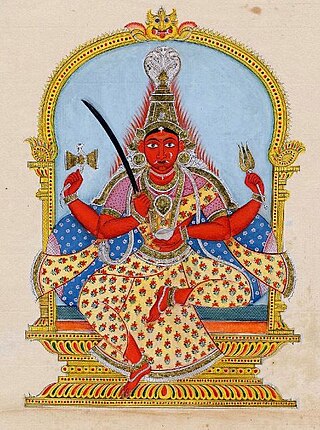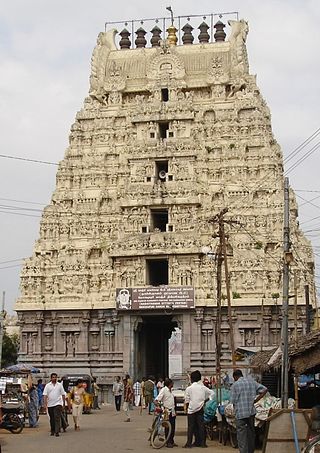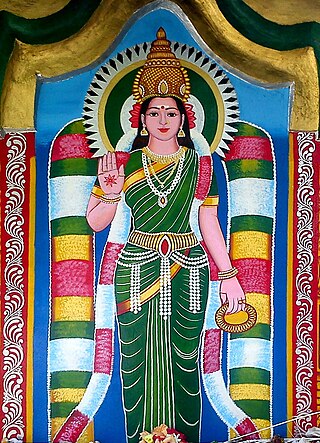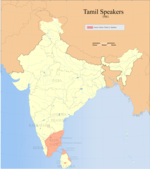
Mariamman, often abbreviated to Amman, is a Hindu goddess of weather, predominantly venerated in the rural areas of South India. Her festivals are held during the late summer/early autumn season of Ādi throughout Tamil Nadu and the Deccan region, the largest being the Ādi Thiruviḻa. Her worship mainly focuses on bringing rains and curing diseases like cholera, smallpox, and chicken pox. Mariamman is worshipped in accordance with local traditions such as Pidari or the Gramadevatai. She is considered as a guardian deity by many South Indian village-dwellers.

Hinduism is one of Sri Lanka's oldest religions, with temples dating back over 2,000 years. As of 2011, Hindus made up 12.6% of the Sri Lankan population. They are almost exclusively Tamils, except for small immigrant communities from India and Pakistan.

Bhadrakali is a Hindu goddess. She is considered to be the auspicious and fortunate form of Adi Shakti who protects the good, known as bhadra.

The Tamil diaspora refers to descendants of the Tamil immigrants who emigrated from their native lands in the southern Indian subcontinent to other parts of the world. They are found primarily in Malaysia, Arab states of the Persian Gulf, South Africa, North America, Western Europe, and Singapore.

Sudalai Madanlit. 'cremation ground chief' is a rural Dravidian folk religion deity worshipped predominantly in South India, particularly in the districts of Thoothukudi, Virudhunagar, Tirunelveli, Tenkasi, Kanyakumari, and Thiruvananthapuram. He is considered by adherents to be a son of Shiva and Parvati. He seems to have originated in some ancestral guardian spirit of the villages or communities in Tamil Nadu, in a similar manner as Ayyanar. He is regarded as a kaval deivam who protects people against evil forces. Sudalai Madan is also called Madan thampuran, Chudala madan, or simply as Madan.

The Sri Kamakshi Amman Temple is an ancient Hindu Temple dedicated to the goddess Kamakshi, one of the highest aspects of Adi Parashakti, the mighty goddess in Shaktism. The temple is located in the historic city of Kanchipuram, near Chennai, India. The temple houses one of the 108 Divya Desams of Vishnu and is called Tirukalavanur. The temple is dedicated mainly to Kamakshi and then to Vishnu in his form of Varaha. The temple is glorified by the 6th-9th century Vaishnavite Alvars in the Naalayira Divya Prabandham. Its construction is credited to the Pallava kings, whose capital was in the same city. This temple, along with the goddesses of Madurai and either Varanasi or Thiruvanaikovil, are the important centers of Shaktism in the state of Tamil Nadu. The present temple is also known as Kamakoti Peetha or Kamakota Nayaki Kovil, where Tripura Sundari had settled after killing a demon. This ancient temple was mentioned in Perunaraatrupadai, an ancient Tamil literature that praises the renowned Sangam era. King Thondaiman Ilandiraiyan of the Pallava dynasty, who ruled Kanchipuram, constructed the temple. Kamakshi is worshipped in the shrine in 5 forms, one of them was a golden idol, which was transported to Thanjavur due to the Muslim invasions of Kanchipuram. There are no other goddess temples in the city of Kanchipuram, apart from this one, which is unusual in a city that has hundreds of traditional temples. There are various legends that account for this fact.

The Sri Lankan Tamil diaspora refers to the global diaspora of Sri Lankan Tamil origin. It can be said to be a subset of the larger Sri Lankan and Tamil diaspora.

Sri Kandaswamy Kovil is a Hindu temple located along Jalan Scott, Brickfields in Kuala Lumpur, Malaysia. The temple is over a century old.

The Coast Veddas, by self-designation, form a social group within the minority Sri Lankan Tamil ethnic group of the Eastern province of Sri Lanka. They are primarily found in small coastal villages from the eastern township of Trincomalee to Batticalao. Nevertheless, they also inhabit a few villages south of Batticalao as well. They make a living by fishing, slash and burn agriculture, paddy cultivation of rice, basket weaving for market and occasional wage labor. Anthropologists consider them to be partly descended from the indigenous Vedda people, as well as local Tamils. Residents of the Eastern province consider their Vedar neighbors to have been part of the local social structure from earliest times, whereas some Vedar elders believe that their ancestors may have migrated from the interior at some time in the past.

Ati Konanayakar or Aathi Koneswaram is a regionally important Hindu temple in Tampalakamam village in the Trincomalee District of Sri Lanka. The name of the temple in Tamil means the "temple of the original lord of Koneswaram". It is situated 24 kilometers (15 mi) from the port town of Trincomalee. The temple was constructed during the 17th century as a successor to the Koneswaram temple that was destroyed by Portuguese colonials in 1622.

Kataragama temple in Kataragama, Sri Lanka, is a temple complex dedicated to Buddhist guardian deity Kataragama deviyo and Hindu War God Murugan. It is one of the few religious sites in Sri Lanka that is venerated by the Buddhists, Hindus, Muslims and the Vedda people. For most of the past millennia, it was a jungle shrine very difficult to access; today it is accessible by an all-weather road. The shrines and the nearby Kiri Vehera are managed by Buddhists, the shrines dedicated to Teyvāṉai and Shiva are managed by Hindus and the mosque by Muslims.

Thambiluvil Kannaki Amman Kovil is one of the most significant Hindu temples in the Ampara District of Eastern Province, Sri Lanka. It is situated about 70 km south of Batticaloa town and 11 km south to Akkaraipattu. It is considered as one of the ancient temples of Mattakkalappu Desam made for Kannaki Amman, the heroine of the great Tamil epic Silappatikaram.
The Pancha Ishwarams are five coastal ancient kovils (temples) built in dedication to the Hindu supreme being Ishwara in the form of the god Shiva, located along the circumference of Sri Lanka.

The Sri Vishnu Thurkkai Amman Temple is a Hindu temple located in the municipality of Dürnten in the canton of Zürich in Switzerland.

Thirukkovil Temple is the most significant Hindu temple in Thirukkovil, Ampara District of Eastern Province, Sri Lanka. It is dedicated to Chitravelayudhar who was once the guardian deity of Mattakkalappu Desam and this temple enjoyed the honor of Desathukkovil of the Batticaloa region. Archaeological and historical evidences suggest that Cholan, Kotte and Kandyan kings maintained strong relations with this temple in the past.

Kannaki Amman is the deified form of Kannagi, the heroine of the Tamil epic Cilappatikāram. She is primarily worshipped in Sri Lanka and Kerala, and in a minor way in few parts of Tamil Nadu. As a goddess of chastity, she is venerated by Indian Tamils and Malayalis, Sri Lankan Tamil Shaivites, and also by the Sinhalese Buddhists as Pattini Amma. In regional Hindu tradition, her tale is interpreted as the story of Durga demanding justice after the death of her husband, Kovalan, who is identified as a form of Shiva.

Ukanthamalai Murugan Kovil is the well known ancient Hindu temple situated in the Okanda, Ampara District of Eastern Sri Lanka, about 145 km south of Batticaloa town. This alluring temple dedicated to Lord Murugan in the heart of Kumana forest is a main stand for the devotees performing pilgrimage to Katirkamam through dense jungle. In places like Pânama and Kumana, which are close to Ukantai, Tamils and Sinhalese lived in harmony even down to the present day.

Muthumariamman Temple or Arulmigu Sri Muthumari Amman Kovil is a Hindu temple in Matale, Sri Lanka.

Tamil Hindus are the Tamil-speaking people who follow Hinduism.




















